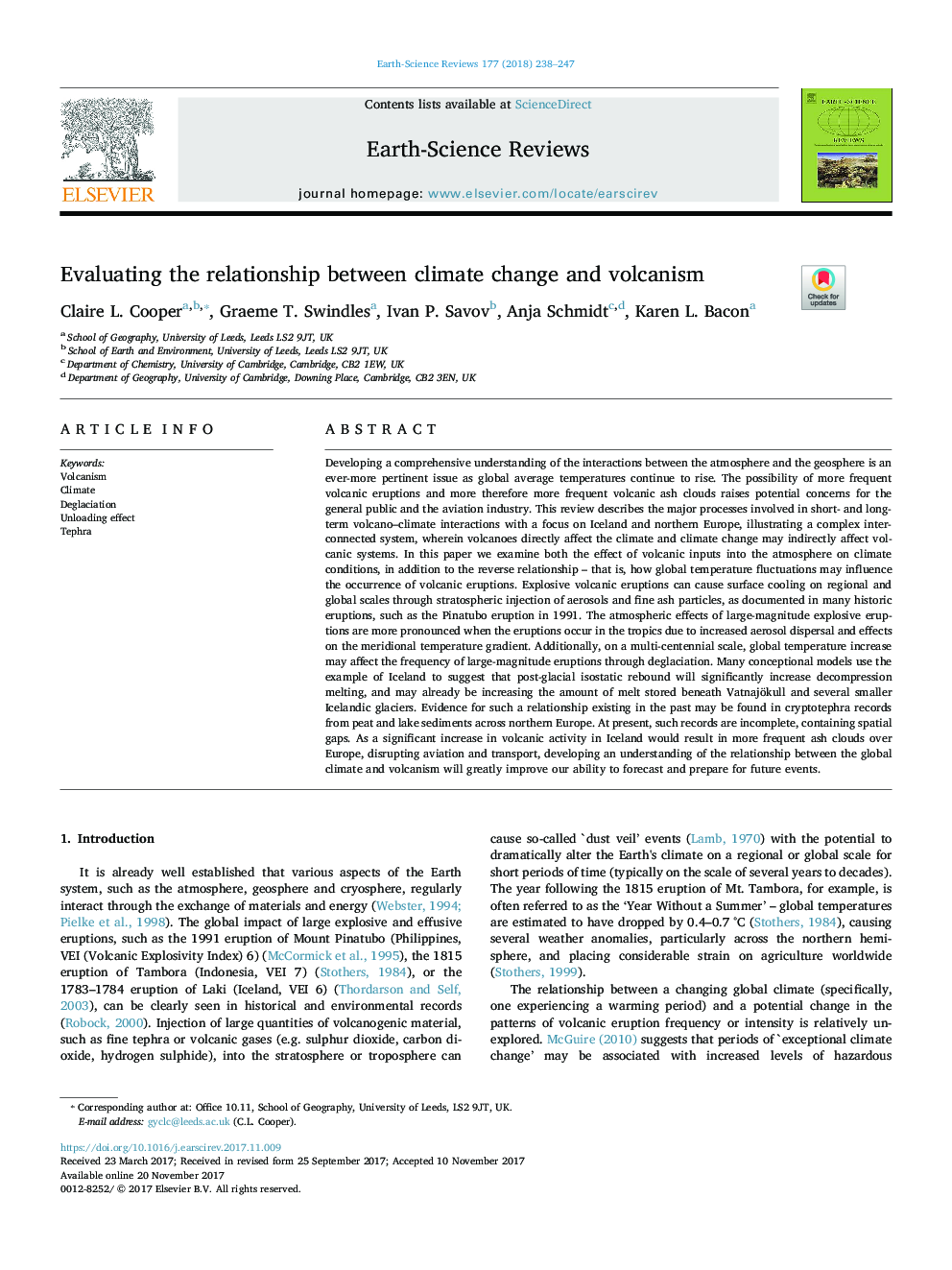| کد مقاله | کد نشریه | سال انتشار | مقاله انگلیسی | نسخه تمام متن |
|---|---|---|---|---|
| 8913045 | 1639925 | 2018 | 10 صفحه PDF | دانلود رایگان |
عنوان انگلیسی مقاله ISI
Evaluating the relationship between climate change and volcanism
ترجمه فارسی عنوان
ارزیابی رابطه بین تغییرات آب و هوایی و آتشفشان
دانلود مقاله + سفارش ترجمه
دانلود مقاله ISI انگلیسی
رایگان برای ایرانیان
ترجمه چکیده
در حال توسعه یک درک جامع از تعاملات بین جو و ژئوسفره مسئله همیشه مرتبط است به عنوان دمای متوسط جهانی به طور مداوم افزایش می یابد. احتمال فوران های آتشفشانی بیشتر و به همین ترتیب بیشتر از ابرهای خاکستر آتشفشانی موجب نگرانی بالقوه برای عموم مردم و صنعت حمل و نقل هوایی می شود. این بررسی فرایندهای عمده ای را که در تعاملات کوتاه مدت و بلند مدت آتشفشان و آب و هوا با تمرکز بر ایسلند و شمال اروپا مطرح شده است، نشان می دهد که یک سیستم پیچیده متصل است که در آن آتشفشان ها به طور مستقیم بر آب و هوا تاثیر می گذارند و تغییرات آب و هوایی ممکن است به طور غیرمستقیم بر سیستم های آتشفشانی تاثیر بگذارد. در این مقاله، هر دو اثر ورودی های آتشفشانی به جو را در شرایط آب و هوایی بررسی می کنیم، علاوه بر رابطه معکوس - یعنی اینکه چگونه نوسانات دما در جهان ممکن است بر وقوع فوران های آتشفشانی تاثیر بگذارد. فوران های آتشفشانی منفجره می تواند موجب خنک کننده سطح در مقیاس های منطقه ای و جهانی از طریق تزریق استراتوسفیک آئروسل ها و ذرات خاکستر ذره ای شود، همانطور که در بسیاری از فوران های تاریخی مانند فوران پیناتوبو در سال 1991 نشان داده شده است. اثرات اتمسفری فوران های انفجاری بزرگ در زمانی که فوران در مناطق گرمسیری به علت افزایش پراکندگی آئروسل و اثرات آن بر گرادیان دما مریدانی رخ می دهد. علاوه بر این، در مقیاس چند صد ساله، افزایش دمای جهانی ممکن است بر فرکانس فوران های بزرگ در اثر انفجار رخ دهد. بسیاری از مدل های مفهومی از مثال ایسلند استفاده می کنند تا نشان دهند که پس از انحلال ایزواستاتیک پس از یخبندان به طور قابل توجهی افزایش ذوب شدن انفجار را افزایش خواهد داد و ممکن است مقدار ذوب ذخیره شده زیر واتناج و کول و چند یخچال کوچکتر ایسلندی را افزایش دهد. شواهدی برای چنین روابط موجود در گذشته ممکن است در پرونده های کریپتوفرا از رسوبات توده و دریاچه در شمال اروپا پیدا شود. در حال حاضر چنین رکوردها ناقص هستند که شامل شکاف های فضایی است. به عنوان یک افزایش قابل توجه در فعالیت های آتشفشانی در ایسلند، ابرهای خاکستری فراوانی را در اروپا ایجاد می کند و هواپیما و حمل و نقل را مختل می کند، درک روابط بین آب و هوای جهانی و آتشفشان، توانایی ما در پیش بینی و آماده سازی رویدادهای آینده را بهبود می بخشد.
موضوعات مرتبط
مهندسی و علوم پایه
علوم زمین و سیارات
زمین شناسی
چکیده انگلیسی
Developing a comprehensive understanding of the interactions between the atmosphere and the geosphere is an ever-more pertinent issue as global average temperatures continue to rise. The possibility of more frequent volcanic eruptions and more therefore more frequent volcanic ash clouds raises potential concerns for the general public and the aviation industry. This review describes the major processes involved in short- and long-term volcano-climate interactions with a focus on Iceland and northern Europe, illustrating a complex interconnected system, wherein volcanoes directly affect the climate and climate change may indirectly affect volcanic systems. In this paper we examine both the effect of volcanic inputs into the atmosphere on climate conditions, in addition to the reverse relationship - that is, how global temperature fluctuations may influence the occurrence of volcanic eruptions. Explosive volcanic eruptions can cause surface cooling on regional and global scales through stratospheric injection of aerosols and fine ash particles, as documented in many historic eruptions, such as the Pinatubo eruption in 1991. The atmospheric effects of large-magnitude explosive eruptions are more pronounced when the eruptions occur in the tropics due to increased aerosol dispersal and effects on the meridional temperature gradient. Additionally, on a multi-centennial scale, global temperature increase may affect the frequency of large-magnitude eruptions through deglaciation. Many conceptional models use the example of Iceland to suggest that post-glacial isostatic rebound will significantly increase decompression melting, and may already be increasing the amount of melt stored beneath Vatnajökull and several smaller Icelandic glaciers. Evidence for such a relationship existing in the past may be found in cryptotephra records from peat and lake sediments across northern Europe. At present, such records are incomplete, containing spatial gaps. As a significant increase in volcanic activity in Iceland would result in more frequent ash clouds over Europe, disrupting aviation and transport, developing an understanding of the relationship between the global climate and volcanism will greatly improve our ability to forecast and prepare for future events.
ناشر
Database: Elsevier - ScienceDirect (ساینس دایرکت)
Journal: Earth-Science Reviews - Volume 177, February 2018, Pages 238-247
Journal: Earth-Science Reviews - Volume 177, February 2018, Pages 238-247
نویسندگان
Claire L. Cooper, Graeme T. Swindles, Ivan P. Savov, Anja Schmidt, Karen L. Bacon,
